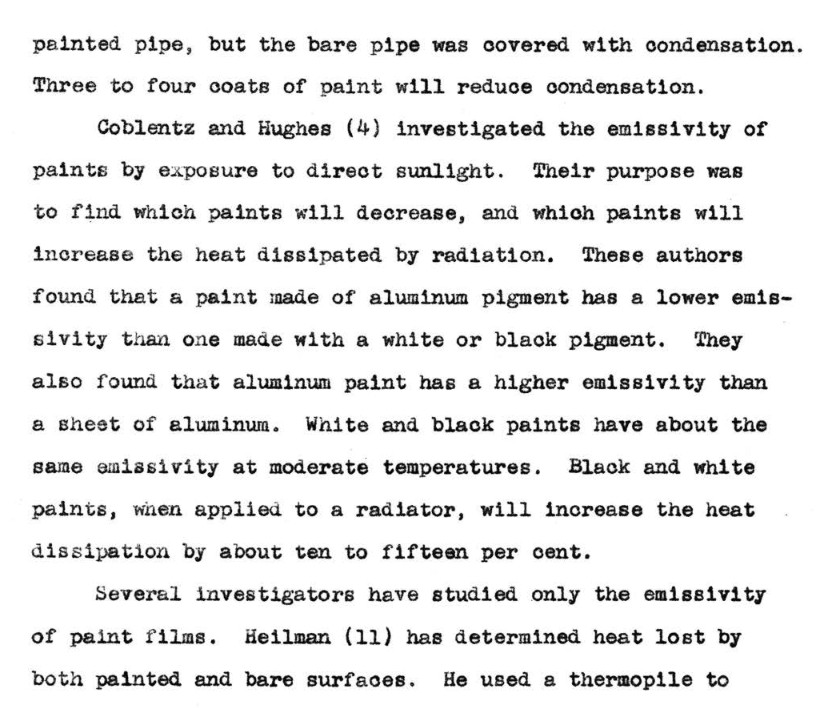


|
 |
|
|
#26 | ||
|
Registered Member
Join Date: Apr 2013
Posts: 1,793
|
IR is invisible..
black anodizing for "this" is just the preferred "color" being more emissive than others (how much more?? sorry never compared blue to red to ect.... I posted enough for others to decide.. Painting is "never" recommended is false. A heat sink in a hood or even house for that matter will not be receiving much outside radiation.. https://www.overclockers.com/forums/...ences-comments As I said.. believe what you want to believe.. Doesn't make it real though..Maybe YOU don't recommend it.. and yes "painting" can be tricky.. There are specialized paints for it but short of dipping and gobbining it on it.. err..works.. What do you want? What more do you need?? Quote:
OK got to agree w/ you on one point.. color matters little BUT that doesn't change the ORIGINAL premise of changing the raw aluminum heatsink to IMPROVE heat transfer be it "anodizing" or painting.. https://www.radianheatsinks.com/heat...ated-heatsink/ Quote:
Last edited by oreo57; 10/27/2018 at 10:29 PM. |
||
|
|

|
|
|
#27 |
|
I'm really very likeable
Join Date: Aug 2016
Location: Down Under
Posts: 676
|
"Practically speaking, a heatsink being coloured is entirely for looks, and will affect cooling less than surface area, airflow, material and the contact between the heat source and heat sink."
https://www.google.com.au/amp/s/www....erformance/amp |
|
|

|
|
|
#28 |
|
I'm really very likeable
Join Date: Aug 2016
Location: Down Under
Posts: 676
|
A heatsink painted black is a bad approximation of a blackbody, more like a 'grey' body where the energy radiated by the formula above is multiplied by a constant (emissivity epsilon) which is less than 1. A better approximation would be a heatsink with microholes with depth about 7x their diameter (the whole appears black inside, try it). This is used by Ersa in their IR heating plates for PCB rework.
To conclude, painting heatsinks black does not contribute to their ability to dissipate heat by radiation. https://www.eevblog.com/forum/projec...black-surface/ |
|
|

|
|
|
#29 | |
|
Registered Member
Join Date: Apr 2013
Posts: 1,793
|
Quote:
Black is just common usage...and a minor part of raw vs non-raw aluminum. Still I bet there are differences but not significant.. couple w/ different "processses" ect.. Fact is anodizing is usually important in passive cooling.. |
|
|
|

|
|
|
#30 |
|
I'm really very likeable
Join Date: Aug 2016
Location: Down Under
Posts: 676
|
The Color
A black object radiates the best - so all heatsinks should be black". True? Not really. Remember, most of the heat is dissipated using forced convection - and for this effect, the color is irrelevant. When doing a comparison test of two otherwise identical heatsinks with a different color, the measured performance difference is usually negligible. The main reason why heatsink manufacturers anodize their heatsinks is to make them look more attractive. Heatsinks exist in a variety of colors - black, silver, but also blue, green, gold, and red. For the performance, it doesn't make any major difference. https://www.anandtech.com/show/437/2 |
|
|

|
|
|
#31 | ||
|
Registered Member
Join Date: Apr 2013
Posts: 1,793
|
Quote:
Painting certainly isn't my "choice" Bl anodizing is.... I've shown where paint can help. like I said let others decide for themselves.. If I was so inclined I'd have no issue spraying a heatsink black.. do I need to quote a real study again?? Quote:
|
||
|
|

|
|
|
#32 | ||
|
Registered Member
Join Date: Apr 2013
Posts: 1,793
|
Quote:
Quote:
NOT at all...passive cooled heatsinks are anodized for a physical reason. Increasing radiative heat transfer...Period. no argument is possible. Re PAINT : https://scholarsmine.mst.edu/cgi/vie...masters_theses 
Last edited by oreo57; 10/27/2018 at 11:03 PM. |
||
|
|

|
|
|
#33 |
|
I'm really very likeable
Join Date: Aug 2016
Location: Down Under
Posts: 676
|
Ok, so anodizing increases emissivity, but the color of the anodize is unimportant. So, as i said the color of a heatsink plays no part in its ability to loose heat.
How heat sink anodization improves thermal performance. For electronics cooling, however, the advantages of surface anodizing are the dielectric isolation of the cooling components from their electronics environment, and the significant increase in their surface emissivity. The pores created by acidic anodizing on aluminum can easily absorb dyes. Colored dyes are often used on heat sinks for cosmetic and marketing purposes. The color of anodization has no impact on radiation heat transfer. A clear anodized surface has the same emissive characteristics as a black anodized surface. https://www.qats.com/cms/2010/11/09/...e-part-1-of-2/ |
|
|

|
|
|
#34 |
|
Registered Member
Join Date: Apr 2013
Posts: 1,793
|
Yes, I got sloppy and caught up in "black" my bad..
most "commercial' passive LED heat-sinks are black. The orig. point was referring to the o/p's "plate' and if it could be improved if using it passively.. Painting or anodizing would help.. 
|
|
|

|
|
|
#35 | |
|
I'm really very likeable
Join Date: Aug 2016
Location: Down Under
Posts: 676
|
Quote:
Even drilling holes in it would increase surface area & improve its performance |
|
|
|

|
 |
|
|